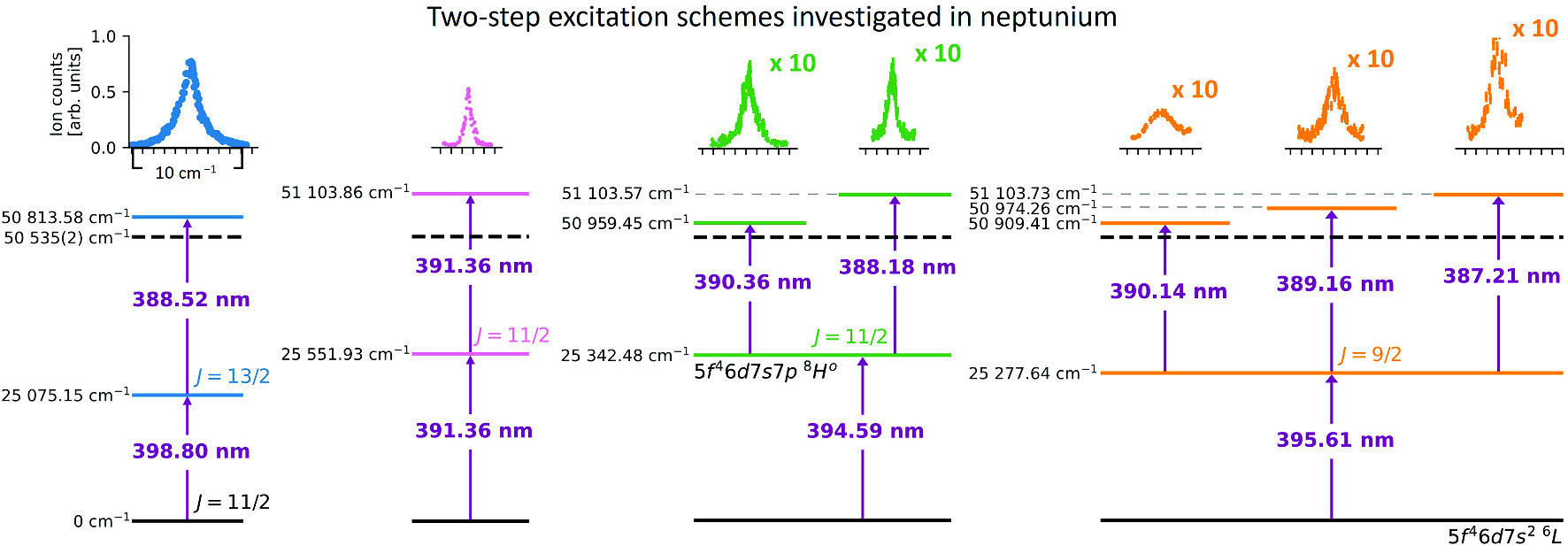https://doi.org/10.1140/epjd/s10053-024-00833-7
Regular Article - Atomic Physics
Resonant laser ionization of neptunium: investigation on excitation schemes and the first ionization potential
1
Institute of Physics, Johannes Gutenberg University Mainz, 55099, Mainz, Germany
2
GSI Helmholtzzentrum für Schwerionenforschung GmbH, 64291, Darmstadt, Germany
3
Helmholtz Institute Mainz, 55099, Mainz, Germany
4
Department of Chemistry - Nuclear Chemistry, Johannes Gutenberg University Mainz, 55099, Mainz, Germany
5
Division Hübner Photonics, Hübner GmbH & Co. KG, 34123, Kassel, Germany
6
Department of Physics, University of Gothenburg, 41296, Gothenburg, Sweden
Received:
30
January
2024
Accepted:
20
March
2024
Published online:
4
May
2024
The atomic structure of neptunium (Np) was investigated by two-step resonance ionization spectroscopy. The study involved exploring ground-state transitions as well as following transitions to high-lying states just below the ionization potential (IP) or auto-ionizing states above the IP. That resulted in the identification of two-step ionization schemes, suitable for trace analysis and nuclear structure investigations. The lifetimes of two excited states located at 25,342.48  and 25,277.64
and 25,277.64  were determined as 230(12) ns and 173(9) ns, respectively. Because of the absence of Rydberg series in wide-ranging spectra recorded, the first IP was determined through the field ionization of high-lying, weakly-bound states using a well-controlled static electric field. By applying the saddle-point model, an IP value of 50,535.54(15) cm
were determined as 230(12) ns and 173(9) ns, respectively. Because of the absence of Rydberg series in wide-ranging spectra recorded, the first IP was determined through the field ionization of high-lying, weakly-bound states using a well-controlled static electric field. By applying the saddle-point model, an IP value of 50,535.54(15) cm [6.265608(19) eV] was derived. This value agrees with the current literature value of 50,535(2) cm
[6.265608(19) eV] was derived. This value agrees with the current literature value of 50,535(2) cm , while providing a more than ten times higher precision.
, while providing a more than ten times higher precision.
© The Author(s) 2024
 Open Access This article is licensed under a Creative Commons Attribution 4.0 International License, which permits use, sharing, adaptation, distribution and reproduction in any medium or format, as long as you give appropriate credit to the original author(s) and the source, provide a link to the Creative Commons licence, and indicate if changes were made. The images or other third party material in this article are included in the article’s Creative Commons licence, unless indicated otherwise in a credit line to the material. If material is not included in the article’s Creative Commons licence and your intended use is not permitted by statutory regulation or exceeds the permitted use, you will need to obtain permission directly from the copyright holder. To view a copy of this licence, visit http://creativecommons.org/licenses/by/4.0/.
Open Access This article is licensed under a Creative Commons Attribution 4.0 International License, which permits use, sharing, adaptation, distribution and reproduction in any medium or format, as long as you give appropriate credit to the original author(s) and the source, provide a link to the Creative Commons licence, and indicate if changes were made. The images or other third party material in this article are included in the article’s Creative Commons licence, unless indicated otherwise in a credit line to the material. If material is not included in the article’s Creative Commons licence and your intended use is not permitted by statutory regulation or exceeds the permitted use, you will need to obtain permission directly from the copyright holder. To view a copy of this licence, visit http://creativecommons.org/licenses/by/4.0/.





